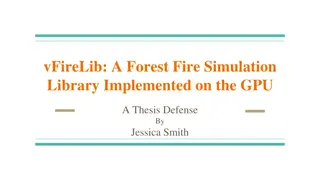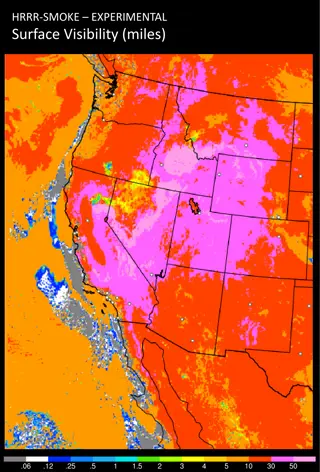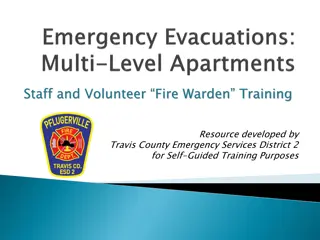Fire and Smoke Modeling Evaluation Effort (FASMEE) Overview
FASMEE is a collaborative project aimed at assessing and advancing fire and smoke modeling systems through critical measurement techniques and observational data. Led by key technical leads, FASMEE focuses on diverse modeling areas such as fire growth, effects, coupled fire-atmosphere behavior, smoke models, and fire ecology. The project's goal is to enhance operational modeling capabilities, improve model applications, and validate underlying scientific theories. Consultations with modelers, scientists, and practitioners play a crucial role in the project's success.
Download Presentation

Please find below an Image/Link to download the presentation.
The content on the website is provided AS IS for your information and personal use only. It may not be sold, licensed, or shared on other websites without obtaining consent from the author.If you encounter any issues during the download, it is possible that the publisher has removed the file from their server.
You are allowed to download the files provided on this website for personal or commercial use, subject to the condition that they are used lawfully. All files are the property of their respective owners.
The content on the website is provided AS IS for your information and personal use only. It may not be sold, licensed, or shared on other websites without obtaining consent from the author.
E N D
Presentation Transcript
Project PIs Technical leads Nancy French, MTU, Houghton, MI Adam Watts, DRI, Reno, NV Roger Ottmar, USFS, Seattle, WA Tim Brown, DRI, Reno, NV Sim Larkin, USFS, Seattle, WA
Background of FASMEE Grew out of a need for a collaborative data set across the research community to: Evaluate current fire models Develop next generation fire models Assess new measurement techniques 2008 Core Fire Science Caucus & 2011 RxCADRE did this informally Formalized through several JFSP grants: RxCADRE (2012), FL JFSP Smoke workshop (2013), Reno FASMEE (2015)
FASMEE Quick Overview - Ideas Perform a sequence of large (>500 acre) prescribed burns Intensively instrumented High end of fuel load range High end of fire intensities At least two locations Southeastern U.S. Western U.S. Maybe Canada* Key observations across 4 disciplines Fuels and consumption Fire behavior and energy Plume development and meteorology Smoke emissions and chemistry Burns will also provide an opportunity for additional, externally funded measurements
Objective of FASMEE To provide critical measurement techniques and observational data necessary to evaluate and advance operationally used fire and smoke modeling systems and their underlying scientific models. Phases Phase 1: Coordination and study plan Phase 2: Field campaign/data analysis/repository
Goal of FASMEE is to collect information that can be used to: Quantify operational modeling capabilities Build confidence in operational modeling capabilities Improve operational model application methodologies Improve model parameterizations Add capability to the models Validate the theory behind the models
FASMEE Targeted modeling areas Fire growth Fire effects (particularly fuel consumption and emissions) Coupled fire-atmosphere behavior, particularly fire behavior and plume development Smoke models, particularly smoke impacts Fire ecology
Consultations with Modelers, Scientists & Practitioners Summer 2015 Coordination Committee Summer 2015 Project Leads Summer 2015 FON Hosting Agency Fall 2015 September 2015 Discipline Leads Selected (January 2016) Data Manager Fuel & Consumption Model Simulation Fire behavior & Energy Meteorology & Plume Smoke & Chemistry FON Phase 1: Funded for coordination and planning, development of funding opportunity notices and completion of study plan September 2016 Observational Teams Selected (February 2017) Fuel & Consumption Fire behavior & Energy Meteorology & Plume Smoke & Chemistry Study Plan, Data Management Plan & IAP February 2017 Phase 2: Funds pending for leading project, data management, host agencies, and data collection, analysis and repository Experimental Burns, Data Collection & Analysis 2018-2020 Final Report, Manuscripts & Data Repository 2021
Agency coordinating members DOD (Environmental Security Technology Certification Program ) NOAA (in particular FIREX) NASA EPA USFS JFSP
Consultations To provide information for drafting an observational data collection specifications document What observations are important to collect How will these observations advance models What are the spatial and temporal resolutions needed 35 in-person consultations completed Continually seeking community input Information is being collected into a specifications document to be made available for review
Modeling Pre-burn simulations planned to Help select burn locations and ignition methodologies Help refine the observational plan in order to ensure that the data collected will be of value in validating specific models Specific model expertise is being sought for WRF FIRE coupled atmosphere-fire model (WRF-FIRE) FIRETEC coupled fire-atmosphere model WFDS coupled fire-atmosphere model (Wildland Fire Dynamics Simulator) WRF-CHEM (preferentially WRF-FIRE-CHEM) coupled photochemical model
Funding Opportunity Notice (FON) (Phase 1) Select scientific leadership Released in September 2015 Multiple task statements By observational discipline Fuels and Consumption Fire Behavior and Energy Plume Development and Meteorology Smoke Emissions, Chemistry, and Transport Modeling
Phase 1 deliverables Fully implementable plan for the field campaign Study Plan Incident Action Plan Logistics, Data Management, Safety Study design validated using model simulations
Hosting Agencies Receptive to research Cooperation Coordination Logistical support Planned burn units that meet FASMEE requirements Incident Action Plan Budget for host agency
Develop a rigorous Incident Action Plan (IAP) Incident Objectives Management Research Health & Safety Plan Organization Chart/Assignments Scientist and technicians list Communications Medical Plan Maps Traffic Plan Air Operations Check in/out procedures
C S A C A A A A A E E A E C A A E E A A A A E C C A E B A M A A A A A A A A A A Pre clip plot Post clip plot Nadir IR HIPs Fire Video Met Tower FBP Radiometer V T F R B Heat budget Soil Heat SODAR < FRX X S 20m < FRXB V FRX FRX FRX Anemometer A T LiDAR FRX V < FRXB FRX V FRX FRXB UAS/manned Boomlift IR EBAM Camera MAPS Balloon E C M B 20m
Liaison Team Considering liaison team between hosting agency and research Logistics IAP Safety Daily briefings Research set up Communications Coordination Rx prescription window Ignition Timing
Potential Host Agencies Targeted research areas Operational burns >500 acres Southeastern US Commonly burned forested landscapes Western US/Canada Heavier fuel load (30+ t/a) (West) Higher intensity fires Ontario Canada Blow-down Likely hosts Fish Lake/Dixie National Forest, UT (mixed conifer/aspen) Kaibab National Forest, AZ (pp/mixed conifer) Fort Stewart, GA (southern pine) Savannah River Site, GA (southern pine)
The Impact of Wildfires on Air Quality, Human Health, and Climate A focused for field project of the NOAA ESRL Chemical Sciences Division FIREX: Fire Influence on Regional and Global Environments Experiment FIREX is a CSD-led interagency collaborative research mission to improve understanding of fire impacts on the environment and human health. Ozone precursors ozone CO2 (hydrocarbons, nitrogen oxides) organics secondary organic aerosol black carbon brown carbon organics FIREX results will help provide a policy-relevant scientific basis for air quality to evaluate fire management approaches. direct emissions other pollutants formed downwind What is Needed? Partners in FIREX are also principals in the Fire and Smoke Model Evaluation Experiment (FASMEE): Joint Fire Science Program USDA/US Forest Service Desert Research Institute US Environmental Protection Agency Information on emissions, especially from different source materials transport and chemical transformations in fire plumes evolution and dynamics of fires and fire plumes Why? To improve 1) air quality transport and forecast models; 2) chemistry-climate models; 3) satellite fire products; 4) models of fire and smoke behavior To understand effects on climate, air quality, and ultimately public health How? Fire lab emission studies CU/CIRES simulation chamber chemistry mechanisms Ground observations and mobile labs small scale filed studies Large scale collaborative field experiment Fuels from large scale experiment: fire lab and simulation chamber Other partners: NASA, University researchers FIREX timetable FIREX and FASMEE distinction and benefits Wildfire <> prescribed fires Detailed chemical transformation schemes for new model development <> validation and evaluation Air quality/climate models <> operationally used fire and smoke models Regional/global scale <> land management community http://esrl.noaa.gov/csd/projects/firex/ Improved understanding of fire emissions and chemistry Better fire weather predictions for on-scene responders Quantitative assessments of human exposure to fire pollutants Expected Payoffs
Aerial data collection / UAS Airborne data a necessary component of most disciplines UAS expected to be involved at all sites to varying degrees Science Team Leads will specify data requirements and FASMEE leadership will work to establish FONs for data collection (cf Observational Teams FON) coming Fall 2016 Focus on mature, deployable/operational platforms & payloads to support data needs (not a UAS development niche)
Lessons-learned, RxCADRE Zajkowski et al. 2016, IJWF
Research Questions Fuels and Consumption How can FASMEE help advance the creation of a system for describing fuels and vegetation that can scale across the wide range of spatial scales needed to address current scientific gaps to operational modeling for decision support (from fine scales to 30-m+ aggregate fuels)? How can FASMEE support the development of new protocols beyond current plot sampling techniques that can better capture both the aggregate information and sub-grid variability needed by the next-generation of fire behavior and fire effects models? How can FASMEE advance the ability of remote sensing to be used to cheaply create stand and forest scale fuels and vegetation maps for land management? How can FASMEE advance the ability to predict unburned areas within larger fires?
Research Questions Fire Behavior and Energy How can FASMEE work with the Tactical Fire Remote Sensing Advisory Committee (TFRSAC) and the operational remote sensing community to advance sensing and calibration of remotely sensed fire detections, fire radiative energy, and burn scars? How can FASMEE work to bridge the scale difference between fine-scale laboratory experiments designed to advance fire behavior theory and coarse scale operational models? How can FASMEE work to advance methods and procedures for operational modeling where fine scale fuel measurements (such as those to be collected for FASMEE) are not available? How can FASMEE advance methods for measuring the amount and pattern of heat flux? How can FASMEE advance methods for measuring convective heat flux?
Research Questions Plume Development and Meteorology How can FASMEE advance the underlying conceptual models of wildland fire plumes? How can FASMEE advance a new generation of improved plume models usable for operational smoke prediction modeling? How can FASMEE advance the operational coupling of coupled fire-atmosphere models with smoke models to improve smoke predictions? How can FASMEE advance the ability to correctly allocate smoke emissions between lofted emissions and non-lofted emissions? How can FASMEE help close the overall fire energy balance budget? How can FASMEE help develop simple and inexpensive protocols for measuring plumes that can be deployed widely?
Research Questions Smoke Emissions, Chemistry and Transport How can FASMEE advance the estimation of emissions and lofting smoke from satellite products? How can FASMEE advance the modeling of nighttime detrainment of smoke in valleys and advance the understanding of smoke drainage flows and pooling? How can FASMEE advance our ability to correctly allocate lofted and non-loft smoke emissions? How can FASMEE be used in conjunction with laboratory experiments to better characterize smoke emissions by phase from various fuelbed types? How do emissions components and ratios vary over the lifetime of a fire and across fire scales? How can FASMEE improve the estimation of uncertainties in emission production models? How can FASMEE help inform the sensitivities and uncertainties in operational models of PM2.5? How can FASMEE develop information useful for ARA s, air regulators and public health officials in creating better health advisories for both firefighters and the public?






























